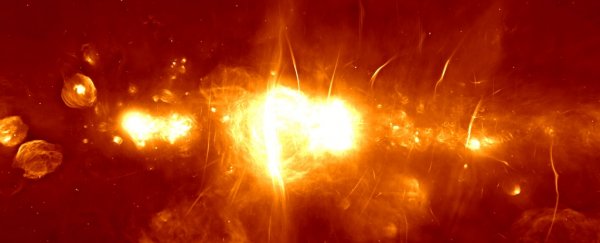As our eyes on the sky grow ever more sensitive, we're going to find more and more things we've never seen before.
Such is the case for a newly discovered source of radio signals, located not far from the center of the galaxy. It's called ASKAP J173608.2-321635, and astronomers have been unable to figure out what kind of cosmic object best fits its weird properties.
Their paper has been accepted for publication in The Astrophysical Journal, and is available on preprint server arXiv.
"We have presented the discovery and characterization of ASKAP J173608.2-321635: a highly-polarized, variable radio source located near the Galactic Center and with no clear multi-wavelength counterpart," explain a team of astronomers led by Ziteng Wang of the University of Sydney in Australia.
"ASKAP J173608.2-321635 may represent part of a new class of objects being discovered through radio imaging surveys."
ASKAP J173608.2-32163 was discovered using the Australian Square Kilometre Array Pathfinder (ASKAP), one of the most sensitive radio telescopes ever built, designed to peer deep into the radio Universe.
It's already proven adept at finding things we have never seen before, such as Odd Radio Circles (we don't know what those are, yet), undiscovered galaxies, and mysterious fast radio bursts.
ASKAP J173608.2-32163 might turn out to be a known type of cosmic object, but if it does, it could end up stretch the definition of whatever object that is.
It's highly variable, emitting radio waves for weeks at a time, and then disappearing on rapid timescales. The signal is also highly polarized – that is, the orientation of the oscillation of the electromagnetic wave is twisted, both linearly and circularly.
ASKAP J173608.2-32163 is also quite a tricky beast to spot. The object, whatever it is, had not been seen before the ASKAP detections, made during a pilot survey of the sky to look for transient radio sources. Between April 2019 and August 2020, the signal appeared in the data 13 times.
Follow-up observations in April and July of 2020 using a different radio telescope, Murriyang in Parkes, Australia, yielded nothing. But the MeerKAT radio telescope in South Africa got a hit, in February 2021. The Australia Telescope Compact Array (ATCA) also made a detection in April 2021.
This supports and validates the ASKAP detections, but also suggests that the source is quite elusive – there were no MeerKAT or ATCA detections prior to that date. Nor did the source appear in X-ray and near-infrared observations, nor in archives of radio data collected by multiple instruments that the researchers checked.
Which leaves a pretty fascinating mystery. The polarization suggests scattering and magnetization, possibly partially due to dust and magnetic fields in the interstellar medium between us and the source, although it's possible that the source itself is also highly magnetized.
All up, it's really hard to figure out what the source might be. There are several types of stars that are known to vary in radio wavelengths, such as stars that flare frequently, or close binaries with active chromospheres, or that eclipse each other. The non-detection in X-ray and near-infrared wavelengths makes this unlikely though.
Flaring stars usually have X-ray emission that corresponds to the radio emission, and the vast majority of stars have ratios of near-infrared emission that should be detectable.
Nor is a pulsar likely: a type of neutron star with sweeping beams of radio light, like a cosmic lighthouse. Pulsars have regular periodicity, on a timescale of hours, and ASKAP J173608.2-32163 was detected fading, which is inconsistent with pulsars. Also, there was a three-month span with no detections, which is also inconsistent with pulsars.
X-ray binaries, gamma-ray bursts, and supernovae were also all ruled out.
However, the object does share some properties with a type of mysterious signal spotted near the galactic center. These are known as Galactic Center Radio Transients (GCRT), three of which were identified in the 2000s, and more of which are awaiting confirmation.
These sources are also yet to be explained, but they have several features in common with ASKAP J173608.2-32163.
If ASKAP J173608.2-32163 is a GCRT, ASKAP's detection could help us find more such sources, and figure out what they are.
"Given that ASKAP J173608.2-321635 is typically not detected and can turn off on timescales from several weeks to as quickly as a day, our sparse sampling (12 epochs over 16 months) suggests that there could be other similar sources in these fields," the researchers write.
"Increasing the survey cadence and comparing the results of this search to other regions will help us understand how truly unique ASKAP J173608.2-321635 is and whether it is related to the Galactic plane, which should ultimately help us deduce its nature."
The research has been accepted into The Astrophysical Journal, and is available on arXiv.
